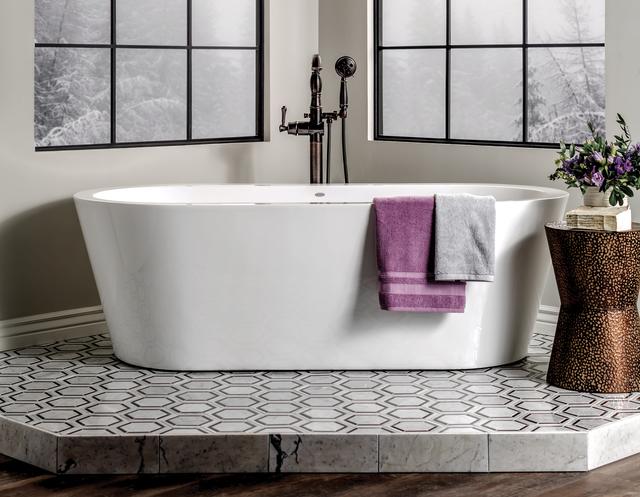A beautiful bath can take bathing to new heights of sophistication, as well as add elegance and a distinctive edge, whether your house is an architectural gem or not. “It is detail that makes the biggest statement when it comes to your home,” says interior designer Natalie Andre of Cott. refurbs + finishes. “The bath has become a real statement piece in bathrooms in recent years.”
So which model to invest in – an inexpensive and practical built-in bath or a classic freestanding one? When making your choice, experts advise your inspiration to be practical as well as aesthetic.
The freestanding bath
Chic and contemporary, a freestanding bath is guaranteed to add longevity to your bathroom.Without any wall support, it is a style that dominates and makes for a strong design feature, be it a traditional clawfoot or pedestal bath in any of its variations. “It is an incredibly elegant addition to a bathroom,” says graduate architect and project manager Clare Mengler, “but you do need to be aware of its pros and cons, starting with who will be using it.”
With babies and toddlers arguably the most frequent bathers, it is important parents are aware of its limitations. “Children and the elderly need to be catered for in terms of getting in and out as there is a great risk of slipping,” agrees Mengler.“You may need to consider fitting it out with a non-slip mat, grab rails, and specific fixtures and fittings, which will make its more functional for them to use.”

When it comes to installation there are certain logistics to keep in mind. “There are practicalities that must be addressed in terms of its installation that requires research and time committed to detail as well as technical awareness about plumbing and drainage,” says Mengler. “You have to consider everything from the fall of the tiles beneath the bath, to how you will control overspray. Given its shape, a glass pane is not going to work, so you will have to hang a shower curtain,” says Mengler.
Given these practicalities, installing a freestanding bath is more successful when it is fitted as part of a brand new build rather than adding one to an existing bathroom. “You can’t just plonk a freestanding bath in a room,” she says. “You must take into account the real likelihood of overflows and over splash or you risk all sorts of annoying consequences like bubbling plaster and paint work, rising damp and mould. Drainage, plumbing and installation must be properly executed.”A freestanding bath avoids some tiling issues, however. There is no silicone edge required and it floats free of the tiled floor, rather than being a continuation of it.
Andre agrees, saying that when installing, ensure there is adequate space between the wall and the bath to ensure easy cleaning. “Map it out so you’re able to get around freely with a mop.”
A built-in bath may not be an exciting choice, but they are popular for good reason.The built-in tub
Step into most Australian bathrooms and you will be greeted by a recessed tub, installed against a wall on two or three sides with a shower curtain or sheet of glass, and perhaps a shower head suspended above. It is a common and more utilitarian option. A built-in bath makes a practical choice for families who must deal with babies and toddlers. “It is safer for children and the elderly because it is more sturdy, and you have a decent tiled edge to lean on and put things on,” Mengler explains.
While a stand-alone bath needs a gracious amount of space to give a suitably elegant and luxurious feel, a built-in bath doesn’t, and it is easier to fit into a tight bathroom. “Because it has a straight edge, you can install a low-maintenance glass shower screen, and a pragmatic rectangular shower alongside or at the end, whereas with a freestanding bath you are very limited. You either go without a shower or you include shower rose above.”
A built-in bath isn’t an exciting choice, Mengler acknowledges, but it’s a solid one used in most bathrooms. “It should be expertly installed for a quality edge. Don’t attempt to use silicone yourself,” she warns. When applied badly it can look very cheap and nasty, and it can’t be painted over. “On application a clean and dry surface is essential, if you want a point of difference use interesting tiles or lay them out in a quirky way.”
